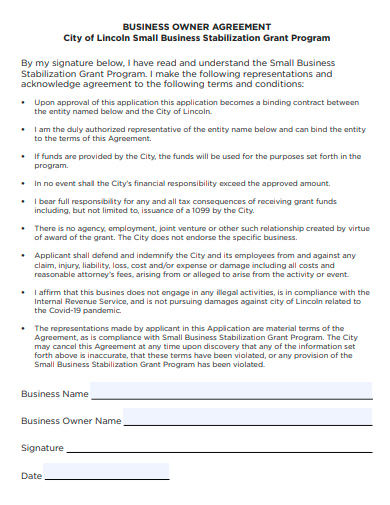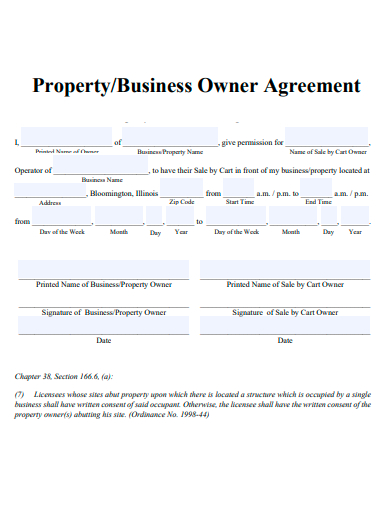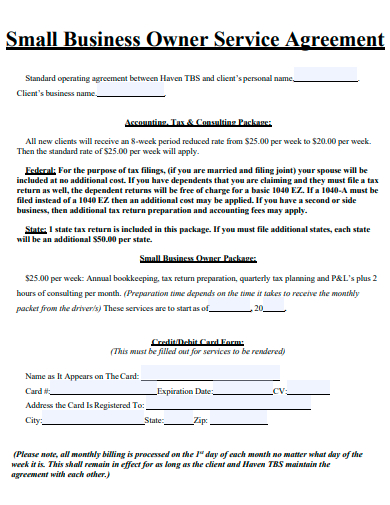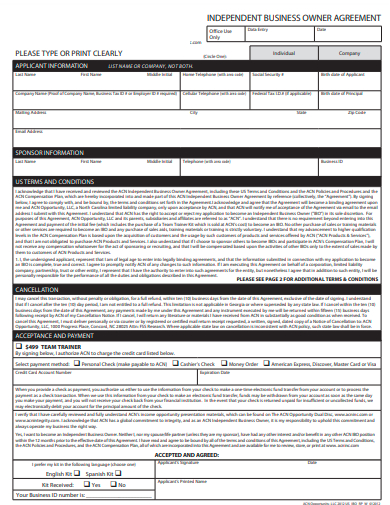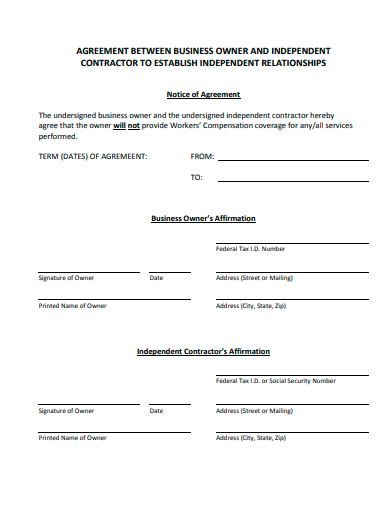Business partnerships where more than two parties are involved must sign a business partnership agreement which is a legal document that guides them on their business operations. This outlines information about each party’s responsibilities, capital contributions, partnership property, each party’s ownership interest, and decision-making conventions. A business ownership agreement is a legal contract between two owners of a business that contains information on how to manage their businesses and determines the rights of the owners.
FREE 4+ Business Owner Agreement Samples
1. Business Owner Agreement Template
2. Property Business Owner Agreement
3. Small Business Owner Service Agreement
4. Independent Business Owner Agreement
5. Business Owner Agreement in PDF
What is a Business Owner Agreement?
A business owner agreement or ownership agreement goes by different names depending on the purpose of your business. If you are establishing a business, it’s called a partnership agreement and in an LLC, this document is called an operating agreement. The business owner agreement aims to define the authority of each party involved in the agreement and how they will handle the alterations once the ownership of the business is changed.
How to Create a Business Owner Agreement?
A business partnership or owner agreement must contain all accountable issues that come with a business co-management which can be done by working with an attorney or using a customizable and printable template. This also contains information on what will happen to the agreement once an owner decides to leave the partnership or how it will be transferred once sold.
Step 1: Provide Information about the Company
The agreement must state the business or company information such as its name, legal structure, and location. It must also state the purpose of the partnership as well as an explanation of certain activities that the business must and must not get involved in. It must also contain details about the business percentage that each party owns as well as an enumeration of their rights and responsibilities.
Step 2: Determine the Process for Decision-Making
Draft an outline of the process for how decisions are to be made and the list of responsibilities of each business partner in managing and handling the decision-making process of their business. Determine who has the financial control of the organization and who must approve when there are additional new business partners.
Step 3: Add Each Partner’s Accounting Obligations
The accounting obligations of each party involved must be included in the agreement as well. Provide the necessary information on the appropriate distribution of profits and losses between business partners.
Step 4: Determine Business Dissolution
In any case that a business partner wishes to dissolve the company or business, the business owner agreement must include instructions on how that dissolution must be handled, procedures for business partners who want to join or leave the partnership, and an outline for the continuity and succession planning for the parties leaving the company.
FAQs
What are the phases of a business owner agreement?
There are four primary phases of business owner agreement to consider which are the initial partnership which involves drafting an agreement, the addition of limited partners as a business develops and expands, the addition of full partners as you promote limited partners into a full business partnership and continuity and succession which explains how responsibilities will be distributed among the remaining partners after partners take their leave from the business.
What elements should a partnership agreement cover?
A partnership agreement must cover key elements such as percentage of ownership, division or profit and loss, length of the partnership, decision-making and resolving issues, authority, and withdrawal or death of a business partner.
What are the different types of business partnerships?
The different types of business ownership are the general partnership which is the most basic form of a business partnership, a limited partnership which are formal business companies that need to be authorized by the state they belong to, the limited liability partnership where all business partners are involved in managing the business, and the limited liability limited partnership in which one general partner operates the business.
A business owner agreement is a legally binding document that provides information on how a business is organized and operated while also clearly defining the roles and responsibilities of each party involved in a business partnership. An ownership agreement varies on the type of purpose and business it serves like partnerships or LLCs but it generally aims to describe the right authority of each business owner and how alterations in the business partnership must be managed.
Related Posts
FREE 10+ Trial Agreement Samples In MS Word | Google Docs | Apple Pages | PDF
FREE 9+ Shop Rental Agreement Samples [ Commercial, Lease, Tenancy ]
FREE 10+ Charter Agreement Samples In MS Word | Google Docs | Apple Pages | PDF
FREE 10+ Mentoring Agreement Samples In MS Word | Apple Pages | PDF
FREE 10+ Partner Agreement Samples In MS Word | Google Docs | Apple Pages | PDF
FREE 10+ Individual Agreement Samples In MS Word | Google Docs | Apple Pages | PDF
FREE 10+ Strategic Agreement Samples In MS Word | Google Docs | Apple Pages | PDF
FREE 10+ Equity Agreement Samples In MS Word | Google Docs | Apple Pages | PDF
FREE 10+ Producer Agreement Samples in MS Word | Apple Pages | PDF
FREE 10+ Grant Agreement Samples In MS Word | Apple Pages | PDF
FREE 8+ Meeting Agreement Samples in MS Word | Google Docs | Apple Pages | PDF
FREE 10+ Community Agreement Samples In MS Word | Google Docs | PDF
FREE 8+ Real Estate Option Agreement Samples in MS Word | PDF
FREE 10+ Call Option Agreement Samples In MS Word | PDF
FREE 10+ Advertising Agreement Samples In MS Word | Google Docs | Apple Pages | PDF

